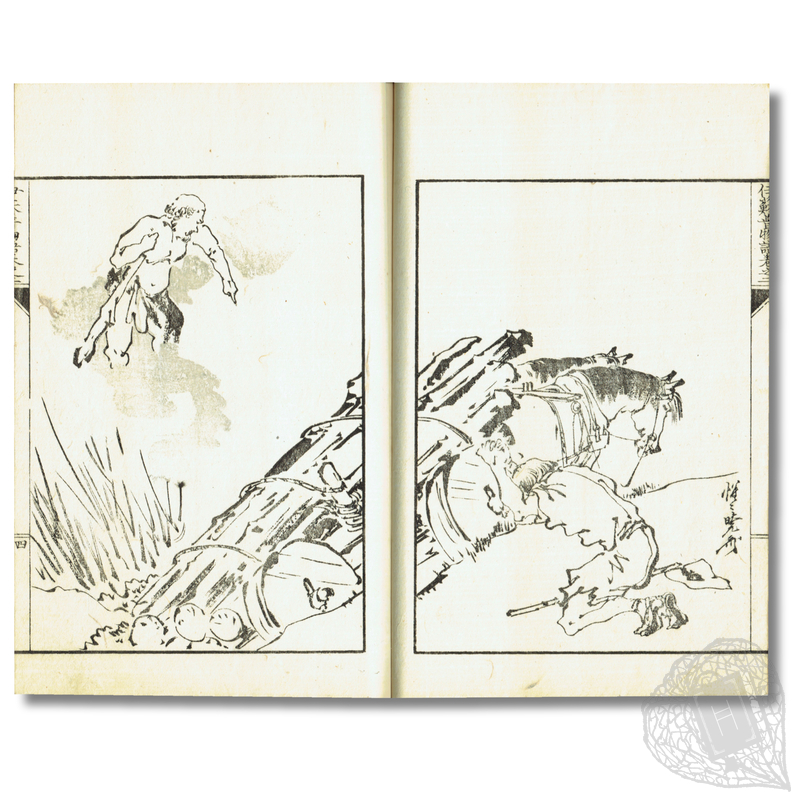Classic Illustrated Books Modern Art and Design Books Translations of Western Texts Japanese Literature Prints and Ephemera Western Books Photo Books Paintings & Scrolls Australia & New Zealand Others
Australia New Zealand Antarctica Japan Korea China Other
Edo Period [1603-1853] Bakumatsu Period [1853-1868] Meiji Period [1868-1912] Taishō Period [1912-1926] Shōwa Period [1926-1989]
Share this book on...

Tsūzoku Isoppu Monogatari (Aesop's Popular Fables)
| US$2,050.00 |  ENQUIRE ENQUIRE |
 BUY BUY |
Tsūzoku Isoppu Monogatari ["Aesop's Popular Fables"]
Aesop [original fables by]; Watanabe, Tazunu [translated by]; Fujisawa, Bainan, Sakaki, Kōson, Kawanabe, Kyōsai, [Tenniel, Sir John], [Wolf, Joseph] [illustrated by].
Tōkyō: Watanabe Tazunu [printing blocks owned by], Yamashiroya Sahē [distributed by], Meiji 5-6 [1872-1873].
The most widely known Japanese version of the Aesopica, translated and self-published by Watanabe Tazunu (1837-1898) in simplified Japanese for members of the public. In this translation, Watanabe, an educator and activist, endeavoured to make 237 fables from the ancient text accessible through simplified, ‘everyday’ Japanese. Watanabe's insightful use of this style of writing, known as wabun, worked, as in later years at least twenty Japanese editions of the Aesopica were based on his translation. Beata Kubiak Ho-Chi (2016) notes in her history of Aesop's fables in Japanese literature that the first five volumes of this work were translated from a revised English translation of the fables by Thomas James published in 1863 (this translation, with revised illustrations, however, was first published in 1858), while the last volume was based on a mixture of premodern Japanese editions of the fables and George Fyler Townsend's Three Hundred Aesop's Fables (1867). Alongside Kyōsai, celebrated artists Fujisawa Bainan and Sakaki Kōson contributed to the work. Many of the illustrations were based on those created by German-born illustrator Joseph Wolf and famed artist Sir John Tenniel for James's text. Nine of the 35 woodblock-printed illustrations in Watanabe's work are attributed to Bainan, three to Kōson, and 23 to Kyōsai. Oikawa (2016) notes in his commentary of the books that “while the contributions by Bainan and Kōson faithfully translate Teniel's [sic] original drawings into the woodblock-print medium, Kyōsai's illustrations, although respecting the original source imagery, are more independent. They are noteworthy for conveying his distinct, individual expression, and Kyōsai's skill and excellence stand out compared with Bainan and Kōson". Early states used extra woodblocks to print light colours and grey tones. Of this set, volumes one, two, four, and five appear to have been printed with the grey blocks, suggesting they are from an early state. A complete set of the most influential Japanese translation of the Aesopica, with illustrations interpreted in Japanese styles by acclaimed artists.
Six four-hole-bound (yotsumetoji) volumes, complete, on double leaves, traditional East Asian binding style (fukurotoji). Original wrappers with light creases and marks. Some binding threads cut. Ex-ownerships stamps to first text page and lower pastedown of each volume. Very occasional light marks internally. First index leaf of v.1 duplicated where second index leaf should be. 3, [1], 3, 3, 32; 3, 27; 3, 39; 2, 27; [2], 29; 2, 28, [1] leaves. 22.6 x 15 cm.
❧ Ho-Chi, Beata Kubiak. "Aesop’s Fables in Japanese Literature for Children: Classical Antiquity and Japan.” In Our Mythical Childhood... The Classics and Literature for Children and Young Adults, edited by K. Marciniak, 189-200. Leiden: Brill, 2016.
❧ Oikawa, Shigeru. "The World of the Japanese Illustrated Book: Tsūzoku Isoppu Monogatari 通俗伊蘇普物語", December 6, 2016. Accessed February 3, 2020. https://pulverer.si.edu/node/389/title/1.
# 240611-6


• Ask a question about this item >
Classic Illustrated Books Modern Art and Design Books Translations of Western Texts Japanese Literature Prints and Ephemera Western Books Photo Books Paintings & Scrolls Australia & New Zealand Others
Australia New Zealand Antarctica Japan Korea China Other
Edo Period [1603-1853] Bakumatsu Period [1853-1868] Meiji Period [1868-1912] Taishō Period [1912-1926] Shōwa Period [1926-1989]
Share this book on...
















